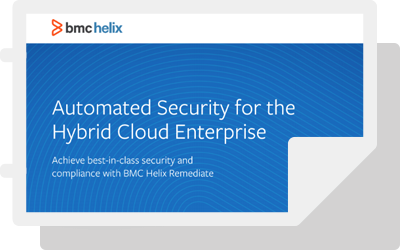As companies embrace cloud adoption more pervasively—across both public and private cloud platforms—the required capabilities for cloud management platforms (CMPs) naturally evolve. Successful deployments by early adopters have brought some fundamental concepts to the forefront. First, cloud solutions need to reduce complexity; they need to automate across complex environments to provide more value with less work. Second, solutions need to address the primary inhibitors to cloud adoption: concerns over compliance and governance. Finally, they need to better secure the primary benefit that most companies seek from cloud: speed of driving digital innovation.
Reduced Complexity
Here’s the irony: As technology continues to become more complex, customers want to leverage the flexibility and power that new cloud platform options provide while being shielded from that complexity in most cases. How do you achieve that?
Modern CMPs extend the traditional infrastructure, providing IT with a “variable compute strategy” that dramatically increases flexibility and speed of delivering digital services. No developer wants to be locked into a subset of the infrastructure types that may be required to solve a problem in the optimal way. At a bare minimum, new clouds must be able to access all the physical and virtual infrastructure within an organization—Windows, AIX, or mainframe; hypervisors like vSphere, KVM, and Hyper-V; as well as public clouds including Microsoft Azure, Amazon Web Services (AWS), IBM SoftLayer, and more.
CMPs must reduce the complexity on top of that stack as well—infrastructure provisioning is now just a basic capability. Knitting together all the different pieces of infrastructure required by complex multi-tier systems should be available to the final user – and automated by the CMP. Supporting containers like Cloud Foundry or Docker; easily provisioning complex environments including databases and middleware servers across complex environments; and automatically scaling up or down based on system load—these are all examples of capabilities that CMPs should provide to improve the productivity of both developers and administrators. After all, if a CMP doesn’t make you more productive, why use it?
Improve Cloud Compliance and Governance
The complete infrastructure, including cloud and traditional IT estates, must be more secure and compliant, not less. And a CMP can help in this regard in four key areas.
The first is governance of the ordering and change process. Of course, for serious cloud deployments, the processes of your organization must be followed. Just as there is an approval process for physical infrastructure, there is an approval process for virtual infrastructure. You must integrate your cloud environment into your service management processes or your cloud will grow out of control and ultimately slower and more expensive than traditional systems. For example, how many organizations have been surprised at their public cloud charges?
Second, all cloud components in a production system should be tracked in the organization’s configuration management database (CMDB). Without these IT processes, managing and resolving issues around production systems is nearly impossible.
Third, compliance of systems in your cloud is no longer optional. Even development systems need to comply with operational standards. Frequently, data and intellectual property on a development system is as important as on a production system. Business must continually provide new value and innovative experiences for customers in order to stay competitive.
Fourth, and finally, best practice security processes need to be followed. While there are many aspects to security, make sure to follow the best practice patching process. More than 80 percent of attacks exploit known vulnerabilities and more than three-quarters of the breaches could be prevented by remediating those issues. Perfecting this process will dramatically reduce the risk of security issues in the cloud.
Accelerate Digital Innovation
In large part, companies are moving to the cloud to speed the delivery of digital services. Business must continually provide new value and innovative experiences for customers in order to stay relevant. However, they sometimes struggle to attain the benefit of speed when they try to deliver cloud services at scale. Part of the reason for that is that the user interaction model of many CMPs is not optimized for use in the wider IT organization. The CMP must be integrated into a single source of service delivery, preferably a formless service delivery catalog, and the service request process must be extraordinarily simple for the end user. Digital innovation initiatives are usually focused on delivering more frequent releases of more apps to web and mobile platforms. This places pressure on IT to support agile app development and deployment processes. Cloud management platforms must enable fast, automated provisioning of dev platforms to support these business initiatives.
Summary
To achieve the benefits promised by cloud computing organizations need to move beyond the idea of a cloud as a separate entity and instead integrate their cloud and traditional infrastructure. IT teams that combine advanced CMPs with best practices processes, such as ITSM processes, compliance, monitoring and configuration management, are able to lead their organizations as they transform their technology platforms into a competitive weapon.







